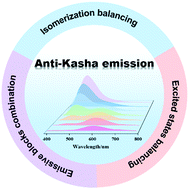Breaching Kasha's rule for dual emission: mechanisms, materials and applications
Abstract
Featuring the atypical photophysical characteristics of dual or multiple radiative decay pathways, anti-Kasha emissive materials have drawn increasing interests in the fields of organic light-emitting diodes, sensing, bioimaging, anti-counterfeiting, information encryption, etc. The investigations on anti-Kasha emissions have been motivated by fundamental and practical demands. However, most organic luminescence materials are restricted by Kasha's rule and only show a single-wavelength emission band in the lowest excited state. To develop anti-Kasha emissive materials, various design strategies, such as ESIPT, excimers, self-assembly, isomerization, and polymerization, were proposed case by case. In this review, recent progress of the anti-Kasha emitters has been summarized in depth according to their relative mechanisms: isomerization balancing, excited state balancing and emissive building block combination. In addition, their precise molecular design strategies, photophysical properties, and applications have also been reported. We hope that this brief introduction will inspire more researchers to focus on this promising field and promote the development of anti-Kasha emissive materials.

- This article is part of the themed collection: Journal of Materials Chemistry C Recent Review Articles


 Please wait while we load your content...
Please wait while we load your content...